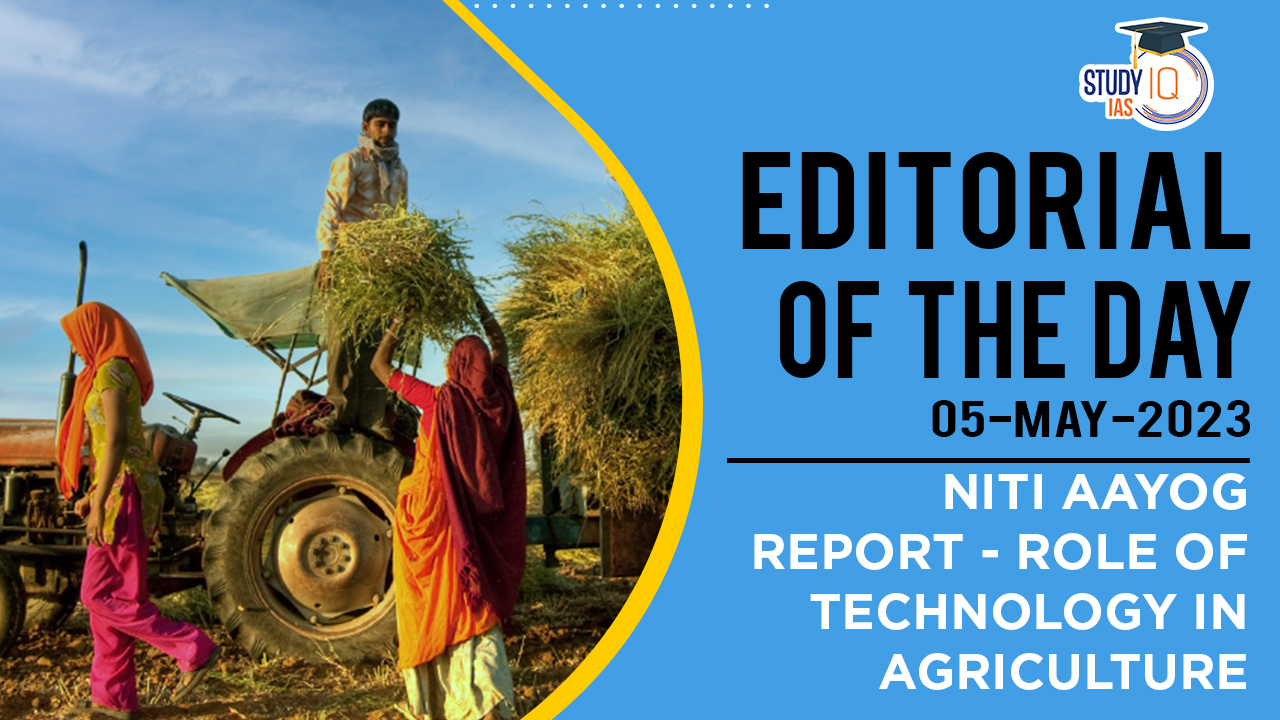Table of Contents
Context: Recently NITI Aayog released a report on “Building agritech ecosystem for the global south” that highlights the potential of agritech startups in transforming the agriculture sector and improving the livelihoods of farmers.
Role of Technology in Agriculture Background
Role of Technology in Agriculture:
The role of technology in agriculture has been crucial and has revolutionized the industry in many ways.
- Improved crop yields: Technology has enabled farmers to increase their yields by using advanced tools and techniques such as precision agriculture, which involves the use of sensors, drones, and GPS to monitor crop growth and optimize inputs such as water, fertilizer, and pesticides.
- Enhancing Crop Quality: Techniques such as Genetic engineering has made it possible to introduce certain strains into other genes of crops or animals. Such engineering boosts the resistance of the crops to pests (e.g. Bt Cotton) and droughts.
- Sustainable farming practices: Technology can help farmers adopt sustainable farming practices, reduce their carbon footprint, and prevent soil degradation. For example, precision agriculture can reduce the amount of chemicals needed to grow crops, while crop rotation and cover cropping can improve soil health.
- Efficient use of resources: Technology can help farmers make the most of their resources by reducing waste and improving efficiency. For example, using sensors to monitor soil moisture and weather conditions can help farmers optimize irrigation and reduce water usage.
- Smart supply chain management: Technology can help farmers connect with buyers and streamline their supply chains, reducing waste and improving profitability. For example, eNAM is an online platform that connects farmers with buyers, helping to reduce the role of intermediaries and improve transparency in pricing.
- Improved quality and safety: Technology can help farmers improve the quality and safety of their products by using tools such as computer vision and deep learning to monitor and grade produce.
- Changes the socio-economic status of farmers: The use of technology can increase productivity, reduce costs, and improve efficiency in farming practices, leading to higher yields and profits for farmers. This, in turn, can improve their economic status and standard of living.
- Additionally, technology can also provide farmers with access to information, resources, and markets. For example, mobile apps and online platforms can provide farmers with weather forecasts, market prices, and information on best farming practices.
- This can help them make informed decisions about their crops thereby preventing crop damage and failure.
- Prevents Rural Exodus: technology can also help to reduce the drudgery of farm work, making it more appealing to younger generations who may have otherwise sought employment in other sectors. This can help to retain young people in rural areas and prevent the rural exodus to urban areas.
Challenges in Deploying Technology in Indian Agriculture:
There have been several challenges in deploying technology in agriculture in India, including:
- Education and Training Related: The lack of knowledge and inadequate skills among farmers regarding the use of technology is a significant challenge.
- Technology and Infrastructure: Poor infrastructure, lack of storage, and inadequate transport facilities pose significant challenges in deploying technology in agriculture.
- Economic and Policy Issues: The lack of money, access to credit, and limited access to bank loans make it difficult for farmers to invest in new technologies. Additionally, government policies related to agricultural technology are not always supportive, which further limits the adoption of new technology.
- Climate vulnerability & Environmental Issues: India is vulnerable to climate change, and farmers face challenges related to poor soils, soil fertility, unreliable rainfall, and natural disasters such as floods, frost, and hailstorms. These challenges can limit the effectiveness of agricultural technologies.
- Psycho-Social Issues: Many workers have no interest in agriculture, and farm work is not always preferred over self-reliance projects or other types of work. Additionally, farm jobs are often time-consuming, which can make it difficult for farmers to adopt new technologies that require significant time investments.
Decoding the Editorial
Key Highlights of the Report:
Agritech Challenge:
- The report discusses the Agritech Challenge which is a collaborative initiative between the United Nations Capital Development Fund (UNCDF), Atal Innovation Mission (AIM) in India, and partner countries such as Indonesia, Malaysia, Kenya, Uganda, Malawi, and Zambia.
- It is aimed at promoting cross-border partnerships and knowledge sharing between agritech startups and incubators in different countries, primarily in emerging economies across Asia and Africa.
- The main objective of the challenge is to address developmental challenges in the agriculture sector, which is critical to the economies of these countries and employs a significant proportion of their population.
- It seeks to create opportunities for business collaborations and knowledge sharing, supported by sustainable investments.
- It aims to drive south-south collaboration by identifying three broad categories of challenges in the agriculture sector, namely low productivity, poor risk resilience, and inefficient supply chain, and seeks to support startups that offer solutions relevant to these challenges.
- The selected agritech startups will work to improve agriculture productivity, build resilience against climate change and natural hazard-induced shocks, and improve supply chain efficiency and transparency.
AgriTech Landscape in India:
- The agritech sector in India has been growing rapidly in recent years, driven by a combination of factors including increasing smartphone and internet penetration, rising agricultural productivity, and government initiatives to promote digital agriculture.
- According to a report by NASSCOM and Agribusiness Intelligence, the Indian agritech market was valued at USD 24 billion in 2020 and is expected to reach USD 30 billion by 2025, growing at a CAGR of 12%.
- However, the market penetration of agritech in India is still relatively low, at around 1%, indicating significant untapped potential.
- The supply chain and farm management segments are expected to be the key drivers of growth in the Indian agritech landscape, with a focus on improving efficiency, reducing waste, and increasing profitability for farmers and other stakeholders.
- There are many agritech startups operating in India across various segments, including precision agriculture, supply chain management, farm management, and market linkages.
- Some of the notable players in the Indian agritech ecosystem include AgNext, Ninjacart, DeHaat, CropIn, and AgroStar, among others.
- The Indian government has also launched several initiatives to promote the growth of the agritech sector, such as the Pradhan Mantri Fasal Bima Yojana, the eNAM platform for online trading of agricultural commodities, and the Kisan Credit Card scheme for farmers.
Challenges for Agritech Startups:
- High Cost of Infrastructure and Devices: The Agritech companies depend on agriculture infrastructure or tools like IoT devices, farm machinery, high-resolution satellite imageries, and IT infrastructure. However, all these infrastructures are costly and require substantial upfront investments. Therefore, the absence of such infrastructures prohibits the entry of the Agritech companies in those geographies or sub-sector.
- Lack of Digital Literacy Resulting in Low Adoption of Agritech Solutions:
- There has been a significant increase in mobile internet coverage, but the usage gap remains a challenge in the adoption of agritech solutions.
- The primary reason for the high usage gap in rural areas is that people are unaware of or understand the mobile internet and its benefits.
- The users also have a low level of literacy and digital skills.
- Other reasons are the affordability of a smartphone or service fees
- Difficulty in Reaching Farmers:
- Connecting with farmers is a significant challenge for Agritech start-ups due to fragmented landholding, diverse geographies, and farmers’ trust issues.
- Farmers do not trust new companies and are averse to doing any transaction.
- The direct connection with the farmer is often the cheapest, but some farm-level issues do not support this model, so start-ups must depend on the B2B2C model.
- Inadequate Farm and Farmer Level Data Set:
- Most Agritech start-ups are data-driven and require the latest data to improve their software and effectively serve end-users.
- In the context of India, the largest repository of data is the government. These data are related to land records, weather data, crop yield, and price.
- However, there is inadequate farm and farmer-level data available, which hinders Agritech start-ups’ growth and development.
Recommendations:
The report recommends few steps to improve the scaling up of agritech start-ups and ensure food security:
- Improving last-mile connectivity: The government needs to build the capacity of local institutions like FPOs or cooperatives to ensure that all smallholders can benefit from the services and products of agritech start-ups.
- Access to public data: The government should ensure that agritech start-ups have access to quality data related to farmers, land records, financial health, weather reports, meteorological data, market, price, and mandi data.
- Promoting local level infrastructure for farm-level processing: The government should promote the creation of local agriculture-related infrastructures by incentivising and providing financing from formal financial institutions. It will boost the farmers’ income and ensure the scalability and sustainability of agritech start-ups.
- Digitalisation of licensing regime: Creating transparency around the licensing process by digitising the entire process will help agritech start-ups increase access to information to the smallholders.
- State-specific AgriTech policy to promote agriculture-based start-ups: A distinct agritech start-up policy will go a long way in promoting and facilitating many such start-ups. It will also help the government departments work around the issues related to sharing of data, usage of data, and privacy issues by the private firms.
Beyond the Editorial
Government Initiatives:
- AgriStack: The Ministry of Agriculture and Farmers Welfare has planned creating ‘AgriStack’ – a collection of technology-based interventions in agriculture.
- Digital Agriculture Mission: This has been initiated for 2021 -2025 by the government for projects based on new technologies like artificial intelligence, block chain, remote sensing and GIS technology, use of drones and robots etc.
- Unified Farmer Service Platform (UFSP): UFSP is a combination of Core Infrastructure, Data, Applications and Tools that enable seamless interoperability of various public and private IT systems in the agriculture ecosystem across the country.
- National e-Governance Plan in Agriculture (NeGP-A): A Centrally Sponsored Scheme, it was initially launched in 2010-11 in 7 pilot States, which aims to achieve rapid development in India through use of ICT for timely access to agriculture-related information to the farmers.
- Sub-Mission on Agricultural Mechanization (SMAM): Under this Scheme, subsidies are provided for the purchase of various types of agricultural equipment and machinery.
- Other Digital Initiatives: Kisan Call Centres, Kisan Suvidha App, Agri Market App, Soil Health Card (SHC) Portal, etc.


 TALASH Initiative: Objective, Key Featur...
TALASH Initiative: Objective, Key Featur...
 Custodial Deaths in India, Types, Issues...
Custodial Deaths in India, Types, Issues...
 MPPSC FSO Recruitment Notification 2025 ...
MPPSC FSO Recruitment Notification 2025 ...





















